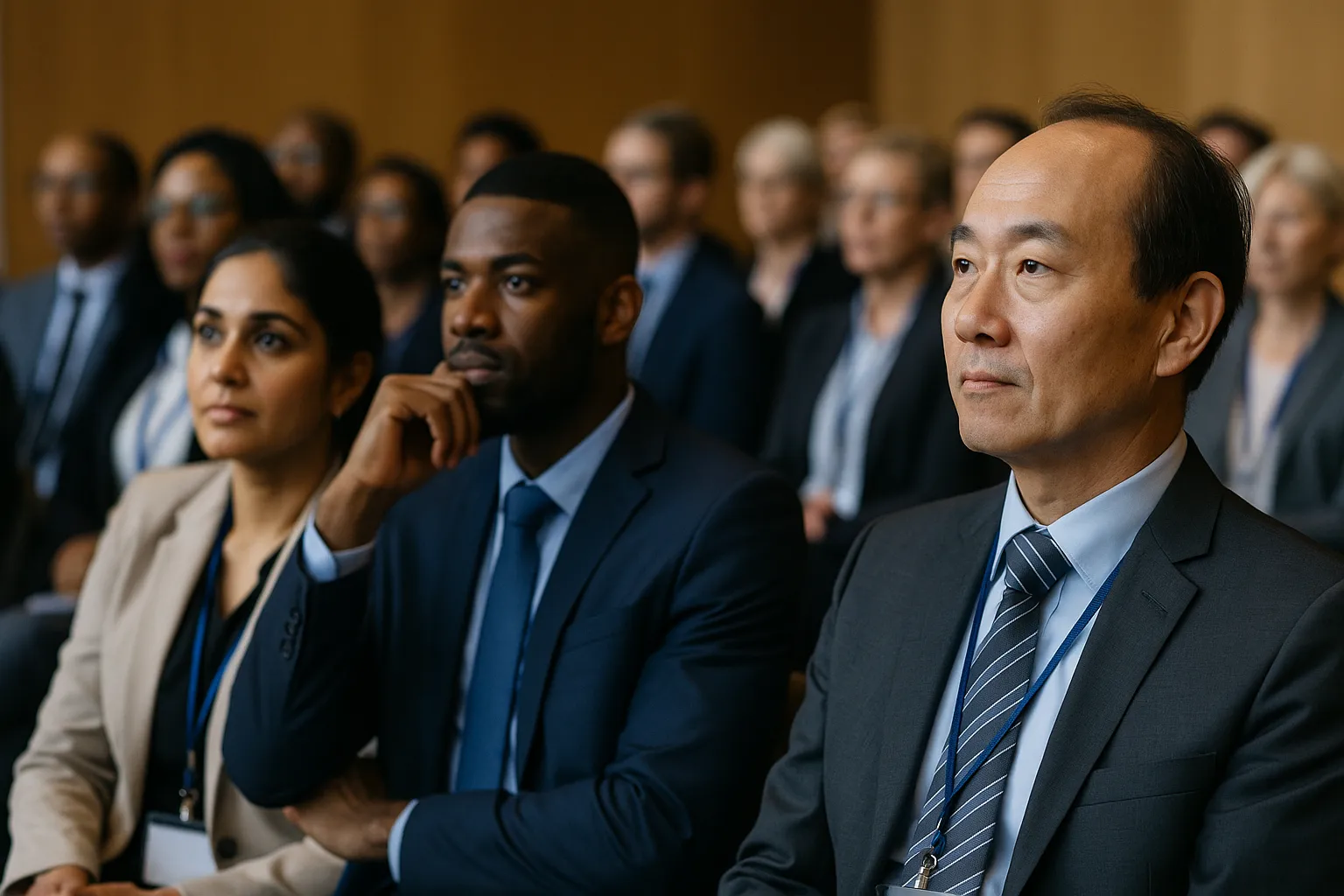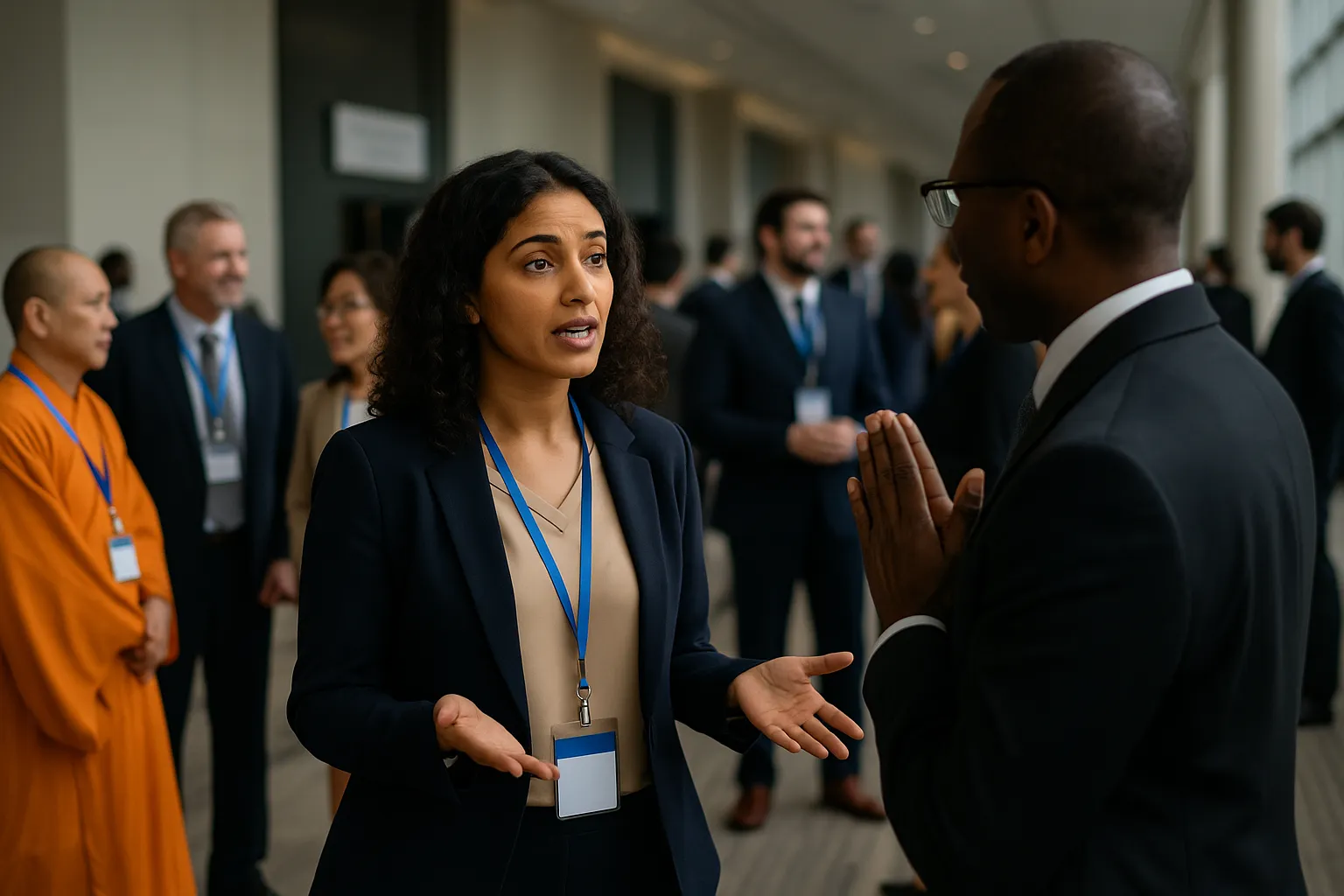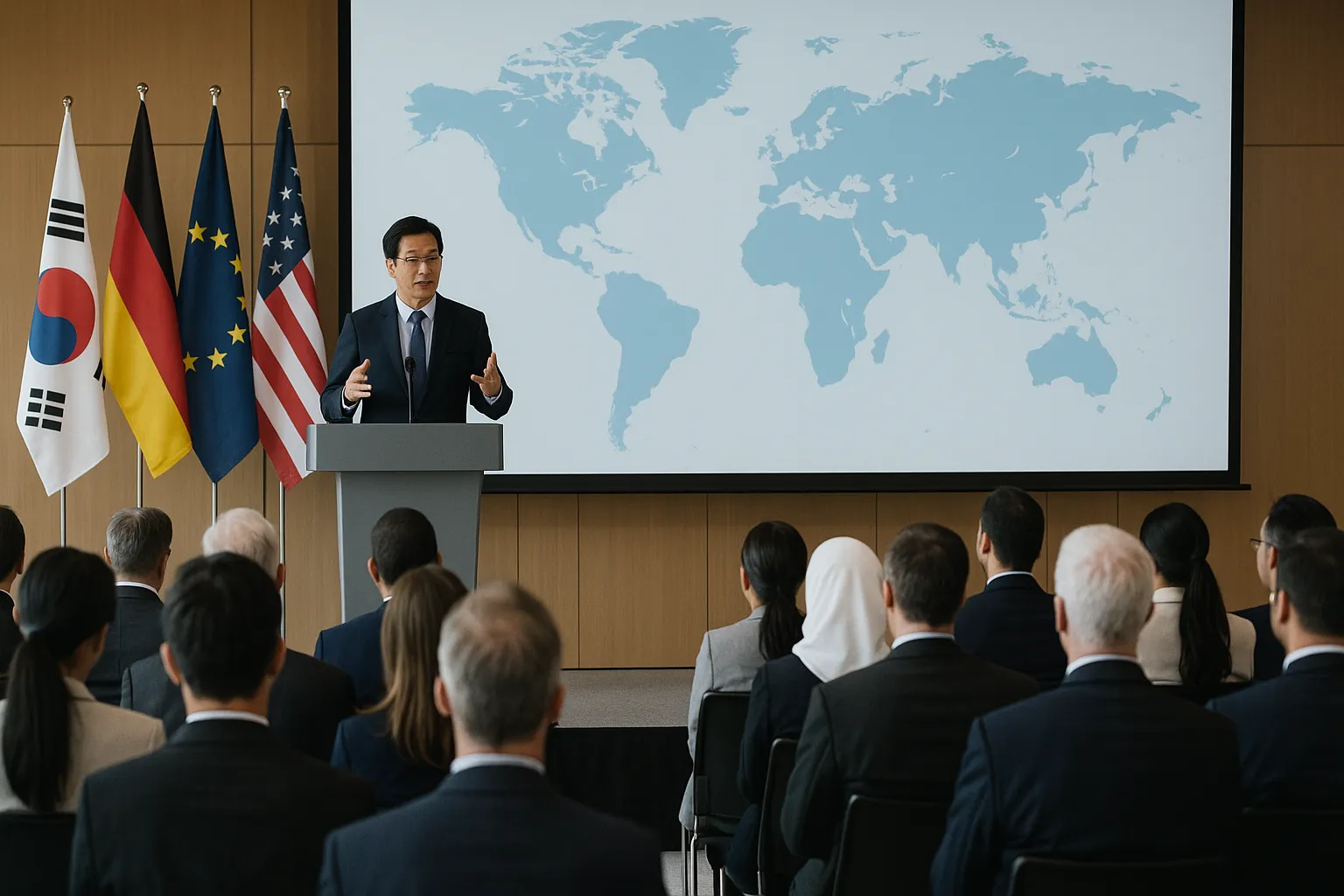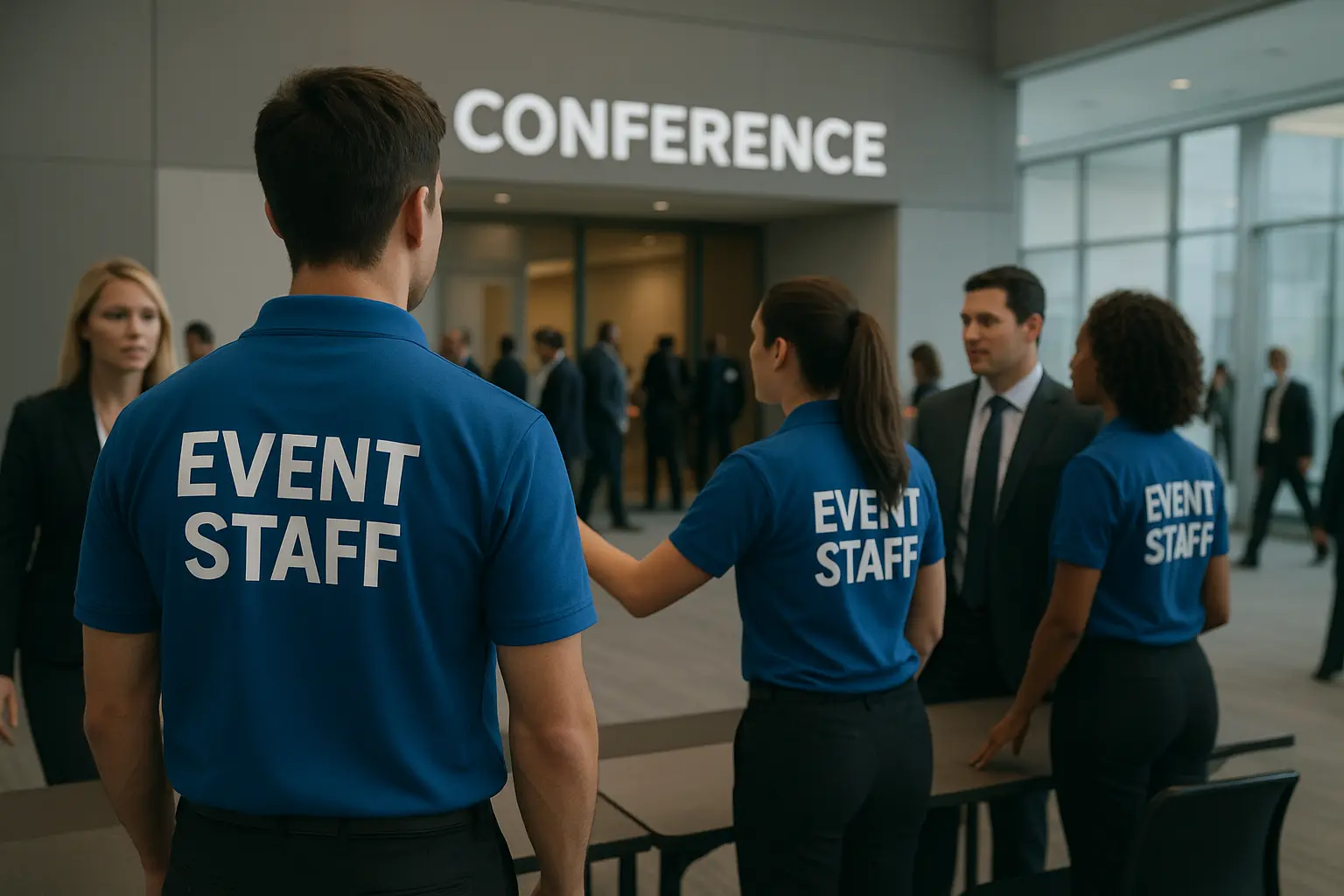CEO Excerpt
“Cultural precision isn’t a soft skill; it’s an operational discipline. When your teams understand nuance, they don’t just represent your brand; they safeguard it in every market.” – CEO, Event Staff
Failing at large-scale event planning isn’t just a logistical mistake; it’s a reputational risk. A single cultural misstep can cost contracts and credibility. We’ve seen it happen: a $10 million product launch nearly derailed because the celebratory hand gesture used on the main screen was a severe insult in a key partner's home market.
Event Staff teams have managed multicultural programs for Fortune 500 conferences across 15+ U.S. cities, from bilingual registration to embassy liaison support. This guide shows how leaders embed cultural fluency into every phase of large-scale event planning to protect brand trust. It also shows how emotional intelligence shapes campaign resonance, as discussed in our guide to maximizing event ROI.
TL;DR: Cultural sensitivity is now a core pillar of large-scale event planning, not just a courtesy. Embedding cultural awareness across research, design, communication, and protocol prevents costly missteps. Culturally fluent teams and AI-driven tools turn inclusion into a measurable advantage for brand trust and engagement.
Why Cultural Sensitivity Matters at Scale
In large-scale event planning, audience diversity is now standard, not a variable. In fact, the Skift Meetings 2025 report shows 60% of corporate events now serve multicultural audiences. Misaligned visuals or tone can trigger immediate backlash. At this scale, the stakes are not just about "being nice"; they are about high-level business outcomes and significant operational risk.
Brand and Reputational Risk
In a hyper-connected world, a single misstep, from an offensive menu item to a misunderstood gesture, is amplified on social media, leading to immediate PR crises, loss of sponsorships, and alienation of key partners.
Financial and Market Impact
Conversely, getting it right builds deep brand loyalty. This is why, as Deloitte’s 2024 Inclusion Report notes, “organizations with inclusive design achieve 2.3× higher engagement,” which translates directly to higher attendee satisfaction, better lead capture, and stronger market penetration.
Operational Friction
On-site, a lack of cultural fluency leads to bottlenecks, guest complaints, and a high-stress environment that degrades the guest experience. This is why C-suite leaders must treat cultural awareness as enterprise risk mitigation. Successful summits like the World Economic Forum embed cultural protocol into their large-scale event planning from day one to ensure diplomatic consistency.
Cultural sensitivity isn’t a theme; it’s a layered operating model, one that builds on foundational standards for risk mitigation and inclusion from our guide on creating a safety plan for events.
Layer 1 – Research & Intent
The first step of large-scale event planning is deep cultural intelligence gathering. This phase is not optional; it is the foundation of your entire risk mitigation strategy. Before a single design choice is made or a date is scheduled, you must identify the full spectrum of your audience, aligning with global frameworks like the EIC Sustainable Event Standards.
This research must be granular, as companies that incorporate cross-cultural research see up to 30% higher client satisfaction rates, according to Harvard Business Review. A superficial-level check for "international guests" is insufficient. A successful research phase includes:
Audience Demographics
Beyond country of origin, map out primary languages, regional dialects, and communication preferences.
Religious & Cultural Observances
Identify major holidays, prayer time requirements, or fasting periods (like Ramadan) that could conflict with scheduling, catering, or event flow.
Dietary & Hospitality Norms
Document a full list of religious dietary laws (e.g., Halal, Kosher), common allergies, and cultural norms around hospitality (e.g., a formal, reserved style vs. a casual, high-energy approach).
Local Etiquette & Symbolism
Research nonverbal cues, common gestures that may be offensive, and the cultural meaning of colors, numbers, and symbols.
Conduct stakeholder interviews and partner with local consultants early in the process. This means speaking directly to international sales teams, regional VPs, and local cultural liaisons.
Example: A Singapore tech expo prevented significant PR issues by mapping religious prayer timings during the large-scale event planning phase, ensuring no keynotes or demos conflicted with these important observances.
Insight for C-Suite: “Data is diplomacy at scale, research prevents retractions.”

Layer 2 – Design & Experience
Every aesthetic choice in large-scale event planning, from stage layout and signage to décor, communicates a message of respect or oversight. Color symbolism and spatial norms vary globally; ignoring them risks alienation and sends a message of cultural ignorance.
This layer translates your research into a tangible, inclusive guest experience. As UNESCO emphasizes, respectful visual communication enhances cultural diversity recognition, making design a key pillar of inclusion. This includes:
Inclusive Menus
Go beyond a single "vegetarian option." A truly inclusive menu features high-quality, clearly labeled Halal, Kosher, vegan, and allergen-free dishes that are as appealing as the main offerings.
Equitable Stage Representation
Ensure panels and speaker lineups reflect genuine diversity, not just token inclusion. This also involves briefing speakers on audience-aware language and pacing.
Universal Design
Implement universal design standards for physical and sensory accessibility. This includes wheelchair ramps, multi-language signage (using clear, sans-serif fonts), and providing quiet rooms for sensory-sensitive guests.
Staff trained on this design intent are crucial for upholding the brand's tone on-site. The small details in large-scale event planning, like the correct order of flags on a stage, the specific lighting color (e.g., avoiding red ink in South Korea), or seating hierarchy, often define whether high-value guests feel seen or sidelined. This requires a level of operational precision in hospitality flow, similar to the detailed planning discussed in our blog How Hospitality Staff Elevate the Guest Experience.
Layer 3 – Communication & Tone
Messaging consistency determines success in large-scale event planning. This layer governs all written and spoken communication, from the first invitation to the final post-event survey.
It is critical to translate materials professionally, not just literally. Machine translation or a non-native speaker will miss the crucial elements of tone and intent. A professional translator ensures:
Idioms are localized, not lost
A common American business slogan can be nonsensical or even offensive when translated directly.
Tone is preserved
The translation must reflect a formal, respectful tone, not a casual or familiar one that may be inappropriate.
Hierarchy is respected
Many languages have formal and informal modes of address (e.g., "vous" vs. "tu" in French) that are critical to get right.
Furthermore, you must train MCs, moderators, and all guest-facing staff to navigate cultural greetings and gender protocols. This includes pre-event testing and audience review to ensure no unintended offense. This training should cover:
- Correct pronunciation of names and titles
- Awareness of modern gender pronouns and inclusive language
- Understanding different cultural styles of audience interaction
(e.g., some cultures are more reserved and will not engage in "call and response").
C-suite Takeaway: “Our operations lead notes, ‘Cultural awareness is measured by how seamlessly guests feel understood without noticing the systems behind it.’ Communication strategy is not decoration; it is brand insurance within large-key event planning.”
Layer 4 – High-Stakes Protocol & Diplomatic Nuance
For C-suite and diplomatic engagements, surface-level sensitivity (like food and holidays) is insufficient. True fluency in large-scale event planning addresses the unspoken rules of power, respect, and hierarchy.
Misunderstanding this layer is a critical failure. For example, teams must be trained on:
High- vs. Low-Context Communication
Staff interacting with guests from high-context cultures (e.g., Japan, Middle East) must understand that "yes" may mean "I hear you," not "I agree," and that relationship-building precedes business. Conversely, low-context guests (e.g., from Germany or the US) expect direct, literal communication.
Protocol & Hierarchy
The order of introductions, seating arrangements at a head table, and correct use of titles (e.g., "Your Excellency," "Honorable") are not formalities; they are political signals of respect.
Symbolism & Gift-Giving
A simple gift can violate anti-bribery laws, like the U.S. Foreign Corrupt Practices Act (FCPA), or be a cultural insult (e.g., gifting a clock in Chinese culture, which symbolizes time running out).
According to The Protocol School of Washington, protocol is the "firewall against diplomatic incidents." In large-scale event planning, your staff is that firewall, and their training on these nuances is a core part of your risk mitigation strategy.
Layer 5 – Feedback & Correction
Mature large-scale event planning relies on closed feedback loops. Use multilingual surveys and staff post-briefs, compiled in portals like Event Staff’s feedback system, to capture cultural insights by language and region.
Review social sentiment and incident logs to spot patterns before they escalate. Integrate data into next-event playbooks to sustain continuous improvement.
Recent Highlight: Spring 2025
Managed bilingual guest flow and provided real-time translation support at the Washington D.C. Global Energy Forum, resulting in zero complaint incidents related to language or protocol.
In enterprise-level large-scale event planning, feedback is not retroactive; it’s real-time quality control.

Integrating All Layers—Operationalizing at Scale
Unify research, design, communication, staffing, and feedback in a single workflow.
Governance teams ensure accountability within large-scale event planning projects. Use analytics tools and tech dashboards for predictive oversight. AI-powered translation tools, for example, now cut communication latency by 40% across hybrid events (Cvent, 2025).
Example: A multinational client reduced guest issues by 28% after building a centralized large-scale event planning control center.
Integration turns cultural awareness from a compliance goal into a competitive advantage.
Cultural Maturity Framework (5-Level Model)
- Level 1 – Token Gestures
Minimal awareness.
- Level 2 – Operational Awareness
Reactive research.
- Level 3 – Process Integration
Cultural checkpoints are embedded in large-scale event planning documents.
- Level 4 – Strategic Alignment
KPIs for inclusion are linked to large-scale event planning outcomes.
- Level 5 – Culture-Embedded Operations
Cultural intelligence institutionalized, staffing aligned with measurement.
Organizations partnering with expert staffing teams can progress from Level 2 to 4 within a year.
Featured Insight: Event Staff Internal Metrics (2024)
- 99.2% Staff Fill-Rate on Multicultural Events
- 98.8% On-Time Check-in Rate
- 8,000+ Annual Hours of Sensitivity & Protocol Training
Methodology
Primary Field Data & Performance Metrics
The core of this analysis stems from proprietary data collected from over 250 corporate events executed by Event Staff between 2022 and 2025. This extensive dataset provides a clear, post-pandemic view of event execution trends. It includes quantitative metrics such as staff fill rates, on-time arrival percentages, client satisfaction scores (CSAT), and average issue resolution times.
We also analyzed qualitative feedback from on-site managers and direct client debriefs to understand the nuances of team performance, adaptability, and brand representation in live environments. This primary data grounds our insights in verifiable, real-world performance, moving beyond theory to capture what actually works on the event floor.
Verified Partner Case Analyses
To ensure our findings are not siloed, we integrated verified case analyses from a network of trusted industry partners. This includes reports from destination management companies (DMCs), major convention center operators, and event technology providers. These analyses provided an external perspective on complex logistical challenges, guest flow management, and the impact of technology on staffing.
By cross-referencing our internal data with these partner reports, we could identify broader industry trends and validate our conclusions. This collaborative approach provides a 360-degree view of event staffing, incorporating multiple viewpoints from the event ecosystem to ensure the strategies presented are robust and universally applicable.
Academic and Business Framework Research
Finally, we contextualized our field data using secondary research from globally recognized thought leaders. Reports from Deloitte provided a high-level framework for understanding current workforce trends and the financial ROI of strategic staffing. Articles from Harvard Business Review (HBR) offered foundational principles on service quality, team management, and the psychology of delivering a premium guest experience.
Furthermore, guidelines from UNESCO informed our approach to cultural diversity and inclusive communication, ensuring our staffing strategies are not only efficient but also respectful and globally aware. This academic layer provides the "why" behind our operational data, linking on-site execution to proven business and cultural strategies.

The Technology Layer—AI, Data & Digital Inclusion
Today, technology is the primary enabler of cultural sensitivity at scale. A mature large-scale event planning strategy uses tech to move from reactive accommodation to proactive inclusion.
AI-Powered Translation
This is no longer a futuristic concept. Tools like Wordly or Interprefy now provide real-time, AI-driven audio translation and captioning for hundreds of languages, making keynote sessions and breakouts accessible to a global audience simultaneously.
Data-Driven Personalization
Modern event registration platforms are crucial for capturing cultural data before guests arrive. This includes not just dietary needs but also pronoun preferences, accessibility requirements, and requests for prayer rooms or quiet zones.
Real-Time Sentiment Monitoring
Using social listening tools to monitor event hashtags across different languages allows planners to spot a cultural misstep (e.g., a poorly phrased tweet, an offensive menu item) in real-time, enabling a rapid response before it escalates into a PR crisis.
As noted in Cvent's 2025 event technology reports, a high percentage of enterprise planners now rely on event apps for dietary and accessibility management, making tech a non-negotiable part of modern large-scale event planning.
The Strategic Imperative of Cultural Insight
True success in large-scale event planning rests on understanding people, not just programs. C-suite leaders who embed cultural insight future-proof their brands and reduce risk. Assess your organization’s cultural maturity, train your teams, and build inclusive protocols before you get a quote for the next phase of large-scale event planning.



.webp)

